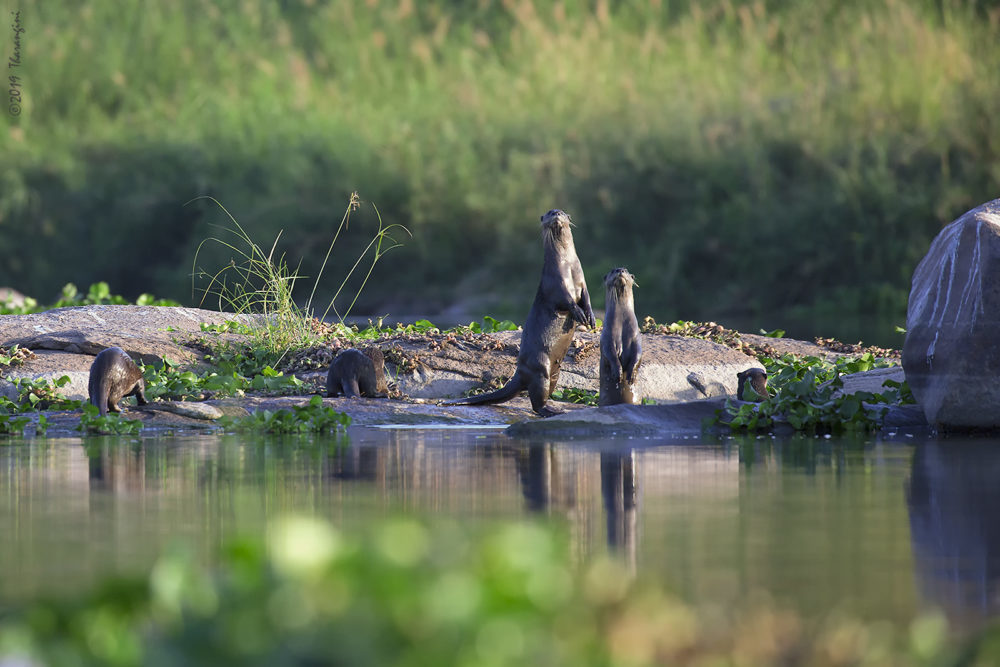by Tharangini Bala
The Otters of Tungabhadra in the world heritage site of Hampi, Karnataka, India has not only evoked protection but also rising concern.
Nearly a 34 kilometer stretch of the Tungabhadra river from Mudlapura village to Kampli in Ballari district has been declared as Tungabhadra Otter Reserve Sanctuary giving the much needed protection to both the smooth coated and short clawed species.
The brilliance of the summer day is at its peak in June-July while the mighty Tungabhadra flows in all her glory buffing the rocks along her banks into impeccable smoothness and carving out mesmerizing designs along the way.
It is obvious as to why Tungabhadra has become a preferred habitat for the smooth coated otters. Freshwater, water hyacinth and every nook, cranny, hole and gaps in the rocks serving as dens has given them a perfect home.
As the evening sets in, crocodiles lazily swim across the glistening waters with their heads barely breaking the surface even as otters start to emerge after their noon break to beat the afternoon heat.
Smooth coated otters are primarily found in the Indian sub-continent and south east Asia and are comparatively larger in size. Since freshwater is highly essential for them, they are usually seen around rivers and large lakes. Otters are presently, listed as vulnerable on the IUCN red list.
Pompayya Malemath, well known conservationist and bird guide from Kamalapur has been observing and working towards their protection along with another well known naturalist and wildlife activist Samad Kottur. He says, “When Tungabhadra was flooded in August 2018 with release of waters from the dam, the number of Otters along this stretch went up. Probably most of them moved downstream and settled here during the flooding.”
Ankit Moun, on a visit to study the species says, “In India, focus is on big carnivores with most funding coming for tigers. Otters are keystone species, if we lose them, we have no others to replace them in riverine ecosystem and the whole system will shrink. As in a jungle, tigers maintain the number of herbivores, Otters too maintain fish, crustaceans and other possible prey.”
They also exchange mineral cycle from aquatic to terrestrial while feeding in water. But they hugely defecate on land for territorial marking. Another interesting aspect – they come onto land and defecate together at specific sites which makes them stay together and mark their territories.
Despite the best conservation efforts, both species continue to face habitat loss with large scale pollution being the main culprit among various other factors. Most wetlands are being converted to settlements or agriculture purpose. Further, hydroelectric projects that are coming up in large scale will affect the river system. Although otters are adapting to changing times and are living alongside humans, man animal conflict continues.
Even in the reserve, they continue to face threats in multiple forms. According to Malemath, ‘Water Bombing’ or ‘Dynamite fishing’ or ‘Blast fishing’ that is being carried out by enterprising youth in the area is one of the major threats. The repercussions of using dynamites for fishing kills and affects all kinds of aquatic life including Otters. It has also effectively reduced their food base with mass fishing. With Otters sometimes damaging the fishermen’s net they have drawn the fishermen’s ire. Poaching for their meat and skin too continues unabated.
Conservationists have been tirelessly working to educate fishermen and make them understand the importance of Otters for the ecosystem and the implications of their dwindling numbers. In fact, some fishermen have now started acting as temporary guides and made efforts to understand the Otters’ behavior.
Otters by nature are curious and playful. They are social but extremely aggressive in a group. Malemath observes that a family of Otters is capable of bullying and scaring a crocodile back into the water for protecting their territory. A family may include a breeding pair and three to four pups from the previous breeding season. Each family tends to have a territory of 7 -12 kilometers as their hunting zone.
Every family has a scout says Ankit. They act as lookouts and give warning yelps or a safe zone signal. Curiosity sometimes makes them go close to humans to observe, investigate and maybe even learn a trick or two.
Although Otters have found a good home in Tungabhadra but more needs to be done. Awareness is the need of the hour so that future generations may not have to see these aquatic animals either in zoo or worse museums only.


ತುಂಬಾ ಸಾರಿ ಇವುಗಳನ್ನ ಆ ಪ್ರದೇಶಗಳಲ್ಲಿ ನೋಡಿದ್ದೇನೆ, ಗಣಿಗಾರಿಕೆ & ಮೀನುಗಳ ಭೇಟೆಯಾಡಲು ಬರುವ ಜನರಿಂದ ಅವುಗಳ ಸಂತತಿಯ ಮೇಲೆ ನಾಶವಾಗುವ ಭಯವಿದೆ.ಹಾಗೂ ಮೀನುಗಳನ್ನು ಅವ್ಯಾಹತವಾಗಿ ಭೇಟೆಯಾಡುವುದರಿಂದ ಅವುಗಳಿಗೆ ಆಹಾರದ ಕೊರತೆಯುಂಟಾಗುತ್ತದೆ..
ಸೂಕ್ಷ್ಮ ಪ್ರದೇಶವೆಂದು ಘೋಷಿಸಿದರೂ ಅವುಗಳನ್ನು ಸಂರಕ್ಷಣೆ ಮಾಡುವಲ್ಲಿ ಇಲಾಖೆ ಎಡುವುತ್ತಿದೆ..